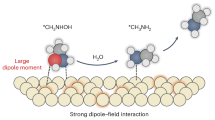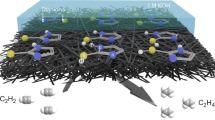Abstract
STUDIES on the hydrolysis of parathion (O-O-di-ethyl-O-p-nitrophenylphosphorothionate) and E.P.N. (thiono-benzene phosphoric acid O-ethyl-O-p-nitro-phenylester) at pH 7 showed unexpectedly that traces of some metal ions, for example, cupric ions, have a marked catalytic effect.
This is a preview of subscription content, access via your institution
Access options
Subscribe to this journal
Receive 51 print issues and online access
$199.00 per year
only $3.90 per issue
Buy this article
- Purchase on SpringerLink
- Instant access to full article PDF
Prices may be subject to local taxes which are calculated during checkout
Similar content being viewed by others
References
Ketelaar, J. A. A., Rec., 69, 649 (1950).
Seidell, A., “Solubilities of Inorganic and Organic Compounds”, supp. to the third edit. (D. Van Nostrand Co.).
Payton, J., Nature, 171, 355 (1953).
Wagner-Jauregg, T., et al., J. Amer. Chem. Soc., 77, 922 (1955).
Kosolapoff, G. M., “Organo-Phosphorous Compounds” (Wiley, 1950).
Author information
Authors and Affiliations
Rights and permissions
About this article
Cite this article
KETELAAR, J., GERSMANN, H. & BECK, M. Metal-catalysed Hydrolysis of Thiophosphoric Esters. Nature 177, 392–393 (1956). https://doi.org/10.1038/177392b0
Issue date:
DOI: https://doi.org/10.1038/177392b0
This article is cited by
-
The hydrolysis rate of chlorpyrifos,O-O-diethylO-(3,5,6-trichloro-2-pyridyl) phosphorothioate, and its dimethyl analog, chlorpyrifos-methyl, in dilute aqueous solution
Archives of Environmental Contamination and Toxicology (1978)
-
Reduction of Parathion induced by Light
Nature (1958)



